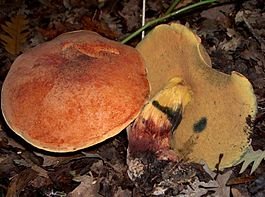Kele oak tree (Suillellus queletii)
- Diviziune: Basidiomycota (Basidiomycetes)
- Subdiviziunea: Agaricomycotina (Agaricomycetes)
- Clasa: Agaricomycetes (Agaricomycetes)
- Subclasa: Agaricomycetidae (Agaricomycetes)
- Comanda: Boletales (Boletales)
- Familia: Boletaceae (Boletaceae)
- Gen: Suillellus (Suillellus)
- Tip: Suillellus queletii (Kele’s oak tree)

line: the hat has a uniform convex shape. 5-15 cm in diameter. The surface of the cap is brown, or occasionally yellowish-brown. Velvety, matte in dry weather, the cap becomes slimy and sticky in high humidity.
Picior: strong leg, swollen at the base. The height of the leg is 5-10 cm, the diameter is 2-5 cm. The yellowish leg is covered with small reddish scales. Fragments of white mycelium are visible at the base of the leg. When pressed, the stem of the mushroom, like the tubules, instantly turn blue.
Pulpă it is yellow in color, instantly turns blue on the cut, dense. In the pulp of the speckled oak, larvae practically do not start. Sour in taste and with a slight smell.
Tubular pores: rounded, very small, red in color. On the cut, the tubules themselves are yellow.
Pulbere de spori: maro măsliniu.
Spread: Kelle’s oak tree (Suillellus queletii) is found in light deciduous forests. Grows in woodlands and clearings, as well as in oak forests, and occasionally in coniferous forests. Prefers infertile, acidic and hard soils, low grass, fallen leaves or moss. Fruiting time from May to October. Grows in groups. Near the oak tree, you can often find pearl fly agaric, common chanterelle, motley moss fly, porcini mushroom, amethyst lacquer or blue-yellow russula.
Comestibilitate: Dubovik Kele (Suillellus queletii) – In principle, an edible mushroom. But it is not consumed raw. Before consumption, mushrooms must be fried to eliminate the substances that irritate the intestines contained in the mushroom.
Similitudine: It is similar to other oaks, which are dangerous and poisonous when raw. You can confuse Kelle’s oak tree with a satanic mushroom, which is also poisonous. The main distinguishing features of the dubovik are red pores, pulp that turns blue when damaged and a leg covered with red dots, as well as the absence of a mesh pattern.









